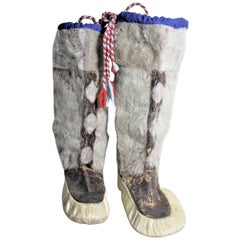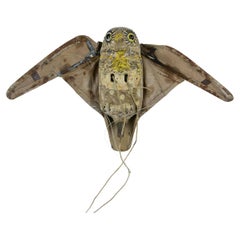Used Mukluks
Mid-20th Century North American Native American Used Mukluks
Fur, Leather, Wool
People Also Browsed
Mid-20th Century English Mid-Century Modern Used Mukluks
Steel
Mid-20th Century French Used Mukluks
Metal, Brass, Tin
Mid-20th Century Japanese Used Mukluks
Mother-of-Pearl, Wood
Late 20th Century Japanese Showa Used Mukluks
Wood
Late 20th Century Japanese Showa Used Mukluks
Wood
Late 19th Century American Native American Used Mukluks
Hide, Beads
Late 20th Century Japanese Showa Used Mukluks
Wood
1970s Mexican Mid-Century Modern Used Mukluks
Terracotta, String, Wood
Late 20th Century Japanese Showa Used Mukluks
Wood
1920s French Used Mukluks
Paper
Late 18th Century English Georgian Used Mukluks
Creamware, Pottery
Late 18th Century Dutch Neoclassical Used Mukluks
Delft, Faience
Late 19th Century French French Provincial Used Mukluks
Upholstery, Oak
Mid-20th Century Mid-Century Modern Used Mukluks
String, Walnut
Mid-19th Century Unknown Folk Art Used Mukluks
Wood
1910s Scottish Late Victorian Used Mukluks
Paper
A Close Look at native-american Furniture
Native American broadly describes any Indigenous people in North America and encompasses hundreds of tribes and groups, all with distinct cultures. Native American–style furniture and decor likewise varies widely, from pieces created by Indigenous people to those appropriated by non-native designers.
Indigenous furniture’s rich heritage includes the bentwood boxes of the Northwest Coast carved from cedar for storing household or ceremonial objects. Generations of Native American people have made baskets for holding household items, with those in the Northeast using sweetgrass and those in the Southeast using pine needles and wicker. Artisans in the Plateau region wove watertight pieces like cradles from plant materials. Although these objects were intricately made, they were usually utilitarian rather than decorative.
The colonization of North America and the removal of Indigenous people from their lands led to the suppression of these practices. Many styles that used Native American motifs — such as Southwestern style, which was heavily influenced by the geometric patterns of Navajo textiles — have historically not involved Indigenous creators and, instead, have taken their traditions without their tribal context.
When decorating a home with Native American–style furniture, it is important to do so respectfully, by understanding the origins of motifs and objects and examining who profits from their sale. There are now Indigenous-led companies, such as Cherokee designer Cray Bauxmont-Flynn’s Amatoya and Totem House Design, promoting Indigenous work in furniture and home decor. Supporting Indigenous artists and artisans is essential to confronting the still pervasive issue of cultural appropriation in design.
Find a collection of Native American living room furniture, folk art, rugs and carpets, decorative objects and other items on 1stDibs.
Finding the Right native-american-objects for You
As part of thoughtful home decor, antique and vintage Native American objects — works created by Native American artists and artisans — can bring rich textures and colors into a space.
Art collecting can be done in a socially and environmentally conscious way that reinvests in local communities. Tribal art is traditionally crafted with earth-friendly materials that respect the environment.
Textiles have long been objects of art and utility for Native Americans. Traditional weaving techniques involve material made from plant and animal fibers. Different tribes have woven distinctive patterns and colors into blankets, rugs and garments, such as the vibrant geometric shapes woven from wool by the Navajo.
After metal and glass beads were introduced to North America by Europeans, they became a popular form of art. Intricate beading appears on clothing, jewelry and other objects. Beadwork not only looks stunning, but it is also deeply emblematic of Native American ethnicity and can be used to pass stories handed down from generation to generation. Beaded garments have often been commissioned for important events like weddings, dances and celebrations.
Native Americans initially created pottery out of necessity to carry water and store food. For centuries, artists have decorated jugs, vases and other vessels, from designs etched into clay to experimentation with firing methods for unique finishes.
Find a diverse collection of colorful and culturally enriching antique and vintage Native American decorative items, objects and much more on 1stDibs.

